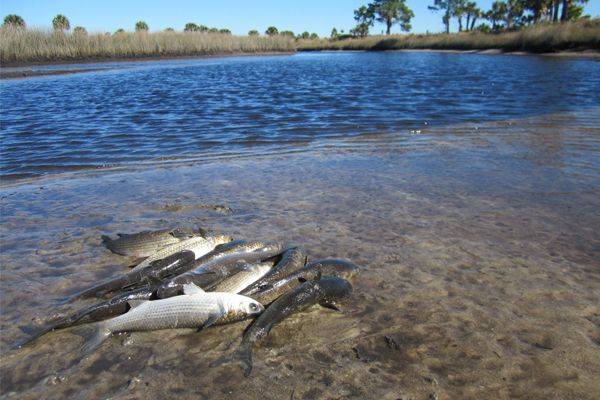by Gary Droze
[dropcap]I[/dropcap]f you go wadefishing in February, dressing for the season is a must. A workmate recently asked what I wear when the water temperature in Apalachee Bay drops below 53 degrees. The answer: T-shirt, shorts and sandals. “Dang,” responded my colleague, “You’re tougher than you look.” Hardly. Once the surf temp descends to the low 50’s, my wading is mostly through fishing magazines in my living room, with the heat turned way up. Warm is good.
On the other hand, too many days of ducking winter’s chill and basking in the marvelous output of HVAC can lead to a serious condition. I’m not talking about boredom. The invention of high speed internet wiped out boredom like the invention of vaccines wiped out smallpox. No, the serious condition I’m referring to is Empty Freezer Syndrome (EFS), wherein one’s supply of fish fillets drops to nil, due to an unwillingness to get one’s arse outside during mercury-challenged days. On such days, it pays to take inspiration from the quotes of great philosophers. Aristotle, Hume, Nietzsche, Jagger.
Let’s go with Jagger, who reminds us daily on classic rock stations that “You can’t always get what you want, but if you try sometimes, you might find you can get what you need.”
What I want in February is consistent spotted seatrout and redfish action, as occurs in the fall and spring. What I need is fresh fish for dinner. If the former just isn’t happening, one way to achieve the latter is to leave the rods home, tuck a big cast net into a backpack, and target the plentiful mullet that hunker down in the St. Marks National Wildlife Refuge levee system. These swimmers, while also susceptible to the hard freezes that kill inshore predator species, are more willing than the fish who outrank them on the food chain to remain in shallow St Marks Refuge creeks.
There are three keys to finding these mullet: 1) Check out the dozens of springs that dot the Refuge along Deep Creek levee. Most of these springs are barely observable except on windless days at low tide. But once you find one, you have found a winter mullet magnet. 2) Seek soft mud bottoms along the levee, where terrain varies and can quickly change from hard-packed sand stretches to oozy mud patches. A careful advance to the edge of a bog – ideally the day after it has been warmed by sunny skies – can yield access to stacks of mullet hugging that cozy warm mud bed. 3) If you discover a likely area, but your net sum is zero after many tosses, do NOT give up. Cold weather mullet don’t so much disappear as concentrate. Two weeks ago, I took my visiting brother-in-law for a mullet mission on the levees. We pummeled a spring-fed, soft-bottomed lagoon from the bank with cast nets for an hour, to no avail. Out of desperation, we waded a half-dozen steps into the muck for a few final throws. SHA-ZAM! Turns out scores of mullet were in there all right, just packed together tightly, and slightly deeper than we supposed. In a handful of casts, we cured ourselves of EFS. Yes, warm is good, but mullet fried fresh in peanut oil is better.


